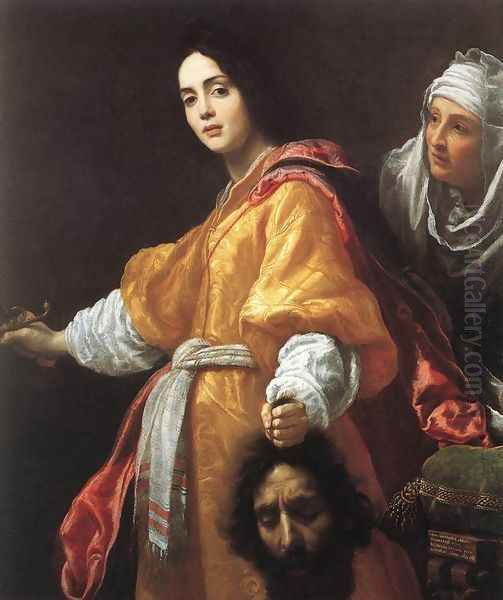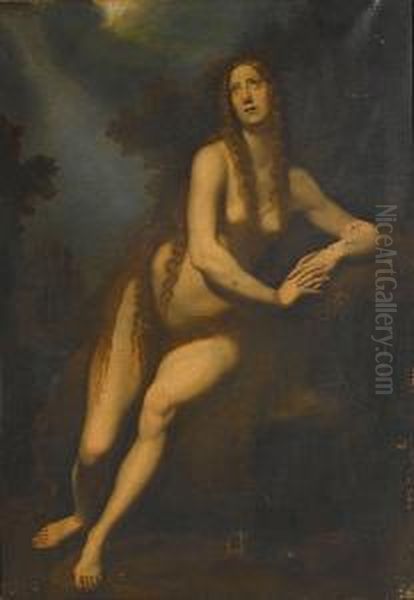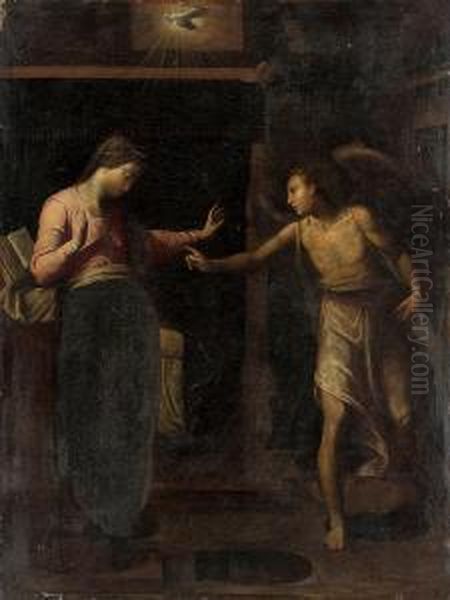
Cristofano Allori stands as a pivotal figure in the transition of Florentine painting from the sophisticated, often artificial elegance of late Mannerism to the dramatic naturalism and emotional intensity of the early Baroque. Born into an artistic dynasty in Florence on October 17, 1577, and dying relatively young in the same city on April 1, 1621, Allori carved out a distinct identity, moving beyond the shadow of his famous father to create works renowned for their technical brilliance, rich color, and psychological depth. His oeuvre, though not vast due to his meticulous working methods and relatively short life, includes portraits, allegorical scenes, and religious narratives, with his interpretation of Judith with the Head of Holofernes achieving iconic status. He navigated the complex artistic landscape of Florence, absorbing influences, engaging with patrons like the powerful Medici family, and leaving a tangible legacy through his art and his students.
Early Life and Artistic Formation in Florence
Cristofano Allori's artistic journey began under the direct tutelage of his father, Alessandro Allori. Alessandro was himself a prominent painter in Florence, a pupil of the great Mannerist Agnolo Bronzino, and known for his large-scale decorative schemes and refined portraits that adhered closely to the late Mannerist style favored by the Medici court. Cristofano learned the fundamentals of drawing and painting in his father's busy workshop, mastering the emphasis on precise draughtsmanship (disegno) that was characteristic of the Florentine tradition.
However, the young Cristofano grew dissatisfied with his father's approach. He reportedly found Alessandro's style, particularly its somewhat rigid anatomical rendering and cool, often sharp color palette, lacking in natural vitality and emotional warmth. This dissatisfaction spurred him to seek alternative instruction, a move that signaled his burgeoning independence and artistic ambition. His desire for a richer, more naturalistic mode of expression was indicative of broader shifts occurring within Italian art at the turn of the 17th century.
Breaking from Mannerism: The Influence of Pagani and Cigoli

Seeking a different path, Cristofano Allori entered the studio of Gregorio Pagani around the late 1590s. Pagani was a key figure among a group of Florentine artists often referred to as "reformers," who sought to move away from the perceived artificiality of late Mannerism. Pagani, along with contemporaries like Ludovico Cigoli and Santi di Tito, aimed to inject greater naturalism, emotional sincerity, and often a richer sense of color into their work, looking back to the High Renaissance masters and incorporating influences from Northern Italy, particularly Venice.
Pagani's studio provided Allori with the environment he needed. Pagani himself was known for attempting to fuse the Florentine emphasis on drawing and structure with the Venetian mastery of color and light (colore). Under Pagani, Allori honed his technical skills while embracing a warmer palette and a more fluid handling of paint. He learned to observe nature more closely and to imbue his figures with a greater sense of life and psychological presence. The influence of Ludovico Cigoli, another leading reformer known for his emotional intensity and dynamic compositions, was also significant during this formative period, further pushing Allori towards the emerging Baroque sensibility.
The Lure of Naturalism: Encountering Caravaggio's Legacy
While firmly rooted in the Florentine artistic milieu, Cristofano Allori was not immune to the revolutionary changes happening elsewhere in Italy, particularly in Rome. The dramatic realism and intense chiaroscuro of Michelangelo Merisi da Caravaggio were sending shockwaves through the art world. While direct documentation of a prolonged stay in Rome is debated, Allori certainly became familiar with Caravaggio's work and its impact, likely through visits, circulated prints, or the presence of Caravaggesque paintings in Florence.
The influence of Caravaggio is palpable in Allori's mature works, especially in his handling of light and shadow to create dramatic focus and heighten emotional tension. Unlike the stark, often harsh contrasts of some direct Caravaggisti, Allori integrated this dramatic lighting into his more polished, Florentine sense of refinement and rich color. He adopted the heightened naturalism and psychological intensity associated with Caravaggio but tempered it with a certain elegance and technical finesse characteristic of his training. This selective assimilation allowed him to create a powerful, personal style that resonated with contemporary tastes.
Masterpiece of Drama and Personal Intrigue: Judith with the Head of Holofernes

Cristofano Allori's most celebrated work is undoubtedly Judith with the Head of Holofernes. Painted around 1613, this masterpiece exists in several versions, with the prime versions housed in the Pitti Palace in Florence and the Royal Collection Trust in the United Kingdom. The painting depicts the biblical heroine Judith, moments after decapitating the Assyrian general Holofernes to save her people. Allori presents Judith not as a vengeful warrior but as a figure of complex beauty, composure, and perhaps a hint of melancholy or weariness.
The painting is a tour-de-force of technical skill. The luxurious fabrics of Judith's gown, the gleam of her jewels, the soft texture of her skin, and the gruesome reality of the severed head are all rendered with meticulous attention to detail and a masterful handling of light that models the forms and creates a palpable atmosphere. The rich, vibrant colors, particularly the golds, reds, and deep blues, showcase the influence of Venetian painting absorbed via Pagani, combined with Florentine precision.
What elevates the painting beyond mere technical brilliance is its deeply personal dimension. According to contemporary accounts, documented by Filippo Baldinucci in his Notizie de' professori del disegno da Cimabue in qua, the beautiful Judith is a portrait of Allori's former lover, the notoriously captivating Maria di Giovanni Mazzafirra, known as "La Mazzafirra." The elderly servant Abra is said to be a portrait of Mazzafirra's mother. Most strikingly, the severed head of Holofernes is a self-portrait of Cristofano Allori himself. This infusion of personal biography into a biblical narrative adds layers of psychological complexity, suggesting themes of love, betrayal, power dynamics, and perhaps the artist's own tormented relationship with his muse. The painting's immense popularity led to numerous copies and variations, cementing its status as an icon of Baroque art.
A Gifted Portraitist: Capturing Likeness and Status
Beyond his narrative paintings, Cristofano Allori was highly sought after as a portraitist. He possessed a remarkable ability to capture not only the physical likeness of his sitters but also their personality and social standing. His portraits are characterized by their refined execution, sensitive rendering of textures (particularly fabrics and lace), and insightful portrayal of the subject's inner life, often conveyed through subtle expressions and poses.

One notable example is the Portrait of Bernardo Davanzati (c. 1605), which showcases his early maturity in the genre. The painting displays a sophisticated understanding of light and shadow, creating a sense of volume and presence, while the sitter's direct gaze and thoughtful expression suggest a keen intellect. Allori received commissions from prominent Florentine families, including the Medici. His work for Grand Duke Cosimo II de' Medici and other members of the ruling family underscores his esteemed position within the Florentine artistic hierarchy. These portraits served not only as records of appearance but also as statements of power and cultural sophistication, aligning with the Medici's long history of art patronage.
Religious Narratives and Later Commissions
Throughout his career, Allori produced significant religious works, often demonstrating a deep understanding of theological nuances combined with emotional resonance. His later career saw an increasing focus on such themes. Works like The Hospitality of Saint Julian, housed in the Pitti Palace, exemplify his mature style, showcasing naturalistic figures, rich colors, and a quiet emotional depth appropriate to the subject of Christian charity.
Other documented commissions point to his activity beyond Florence, although some details remain debated by scholars. Sources mention a ceiling painting depicting The Embarkation of Marie de' Medici for a church in Pisa (possibly San Stefano dei Cavalieri, linked to the Medici-founded Order of Saint Stephen) and a Saint Catherine of Siena Praying before the Assumption for the church of San Domenico in Parma. While the specifics of these commissions require careful consideration, they indicate the reach of his reputation. A work like the Resurrection mentioned for Pistoia Cathedral would fit the pattern of his later focus on significant religious narratives, executed with his characteristic blend of elegance and feeling. These works solidified his reputation as a leading religious painter of his generation in Tuscany.
Life Imitating Art: The Turbulent Relationship with La Mazzafirra
The relationship between Cristofano Allori and Maria di Giovanni Mazzafirra ("La Mazzafirra") was a defining aspect of his life and art, adding a layer of dramatic intensity often mirrored in his paintings. Described as both captivating and tempestuous, La Mazzafirra served as his model for several key figures, most famously Judith and potentially Mary Magdalene in other works. This relationship, however, was reportedly fraught with passion, jealousy, and conflict.
The connection became so tumultuous that, according to Baldinucci, Allori, in fits of despair or anger related to La Mazzafirra, actually damaged or destroyed paintings he had based on her likeness. Specifically mentioned are versions of Judith and a Magdalena. These were later said to have been acquired and restored by Michelangelo Buonarroti the Younger (grand-nephew of the famous sculptor and architect), a contemporary writer and cultural figure in Florence, who supposedly inscribed the reasons for the damage on the back of the panels. This anecdote vividly illustrates the potent and often destructive interplay between Allori's personal life and his artistic creation, lending a biographical charge to works like the Judith.
Technical Mastery and the Shadow of Influence
Cristofano Allori was universally acknowledged, even by critics, for his exceptional technical skill. His meticulous approach meant his output was relatively small compared to more prolific contemporaries. He was a master of drawing, using preparatory studies in red and black chalk, sometimes heightened with white, to carefully plan his compositions. His handling of oil paint was refined, achieving smooth finishes, luminous skin tones, and convincing textures, from shimmering silks to rough hair.
His technical prowess, however, sometimes led to complex discussions about originality and influence. His admiration for earlier masters, particularly Correggio, was well-known. Allori made copies of Correggio's works, and according to some accounts, these copies were executed with such fidelity and skill that they were occasionally mistaken for originals by Correggio himself. While intended as a testament to Allori's ability, such stories also fueled whispers that some of his own compositions were perhaps too heavily reliant on established models, lacking true innovation. This debate highlights the complex relationship between imitation, emulation, and originality in the art world of the period.
A Teacher's Legacy: Shaping the Next Generation
Despite his relatively short career, Cristofano Allori played a role in educating the next generation of Florentine painters. He maintained a workshop, and several artists are recorded as having studied with him or been significantly influenced by his style. Among his notable pupils were Zanobi Rosi, who became a close assistant and completed some of Allori's unfinished works after his death, and Giovanni Battista Vanni, who went on to have a successful career as a painter and engraver. Other artists associated with his circle include Lorenzo Lippi and Francesco Furini, though the exact nature of their relationship might be more influence than direct tutelage.
Through his teaching and the example of his work, Allori helped perpetuate the Florentine tradition of strong drawing combined with the newer Baroque emphasis on color, light, and emotion. His students absorbed his meticulous technique and his ability to convey psychological depth, contributing to the continued development of Florentine painting in the 17th century. His influence extended beyond his direct pupils, as his major works, particularly the Judith, remained highly visible and admired in Florence.
Enduring Influence: Allori's Place in Art History
Cristofano Allori occupies a significant place in the history of Italian Baroque art, particularly within the Florentine school. He successfully navigated the transition from the sophisticated but often emotionally cool world of late Mannerism, inherited from his father Alessandro Allori and the legacy of Bronzino, towards a more dynamic, naturalistic, and emotionally engaging Baroque style. He synthesized Florentine disegno with Venetian-inspired colore, and absorbed the dramatic potential of Caravaggio's realism without sacrificing elegance.
His masterpiece, Judith with the Head of Holofernes, remains one of the most compelling images of the period, admired for its technical perfection, psychological complexity, and the intriguing blend of biblical narrative with personal drama. His portraits stand as sensitive records of Florentine society, and his religious works contributed to the revitalization of sacred art in the early Seicento. He stands alongside figures like Ludovico Cigoli as a key proponent of the Baroque style in Florence, influencing subsequent generations. While perhaps overshadowed on the grand Italian stage by Roman or Bolognese contemporaries like Guido Reni, Guercino, or Artemisia Gentileschi (with whom he might have interacted, given her time in Florence), Allori's contribution to the specific character of Florentine Baroque is undeniable.
Conclusion
Cristofano Allori's art offers a fascinating window into the artistic currents of Florence at the turn of the 17th century. Emerging from the shadow of a famous Mannerist father, Alessandro Allori, he forged a distinctive style under the guidance of reformers like Gregorio Pagani, embracing naturalism, rich color, and emotional depth. Influenced by the dramatic realism of Caravaggio yet retaining a Florentine elegance, he created works of remarkable technical skill and psychological insight. His Judith with the Head of Holofernes, infused with personal intrigue involving his muse La Mazzafirra, became an enduring masterpiece. As a sought-after portraitist for patrons like the Medici and a creator of moving religious narratives, Allori left an indelible mark. Though his life was cut short, his meticulous craftsmanship, his ability to convey complex emotions, and his role as a bridge between Mannerism and Baroque secure his legacy as a significant master of Italian painting.